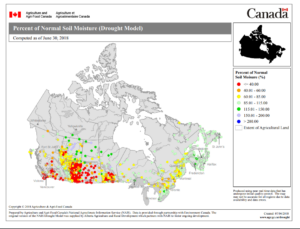Drought management strategies
Remarque : cette page web n’est actuellement disponible qu’en anglais.
Editor’s note: Due to dry conditions in many parts of the country, we’ve pulled this article from our archives. It was originally posted in July 2015.
For timely timely information on weather and climate relevant to the agricultural sector in Canada, visit Agriculture and Agri-Food Canada’s Drought Watch webpage.
Whether in the form of pasture, stored forage, or supplements, feed is the largest variable input cost in cow-calf operations. A big challenge is to feed the cow in a way that meets her current and future nutritional requirements for maintenance, lactation, maintaining a successful pregnancy, giving birth and getting rebred within 80-85 days of calving as cost effectively as possible. This challenge is obviously much greater during drought, when feed is scarce and expensive.
Aside from moisture, one thing that will help keep you and your cows from experiencing a wreck this summer is knowledge. We’ve pulled together a good list of resources that can help you and your herd get through the drought.
So pour yourself a coffee or an iced tea, and delve into the links below. After a few hours of reading, you’ll likely have a few new plans to keep your cows and grass in good shape, and to keep from shelling out more money for feed or vet bills than need be this year and down the road.
Let us know if the information you’re seeking isn’t here, or if we’re missing some valuable information you’ve found elsewhere so that we can add those links to this list.
- Managing cow herds during drought (University of Nebraska)
- Stretching Feed Supplies (BCRC Blog post)
- Surrounded by ‘Graziers’ — Planned Grazing Management Take-Homes (RealAgriculture.com)
Pasture and range management strategies:
- Video: How to Manage for Drought with Grazing (Foothills Forage and Grazing Association)
- Managing grazing lands through drought (B.C. Ministry of Agriculture)
- Range and pasture management when dealing with drought (Alberta Agriculture and Forestry)
- Drought Management Strategies (BCRC Web page)
Toxic plants such as spotted water hemlock, poison hemlock, seaside arrow-grass, death camas, tall and low larkspur and timber milk-vetch can be a particular risk in dry years. If they’re the only thing left in the pasture, they may get eaten.
- Common weeds poisonous to grazing livestock (Ontario Ministry of Agriculture, Food and Rural Affairs)
- Toxic Pasture Plants (BCRC webpage)
Other toxin risks: Stressed plants can accumulate high levels of toxic compounds and stored feed eventually deteriorates. When ponds evaporate, the minerals left behind can reach dangerous levels.
- Nitrates (BCRC Web page)
- Prussic acid and green flax – FAQs (Saskatchewan Ministry of Agriculture)
- Molds (Alberta Agriculture and Forestry)
- Blue-green algae – FAQs (Saskatchewan Ministry of Agriculture)
Creep feeding helps weaning weights when pasture conditions and milk production are poor
- Creep feeding calves (Saskatchewan Ministry of Agriculture)
- Creep feeding (Manitoba Agriculture)
Early weaning can take nutritional pressure off the cow and grazing pressure off the pasture.
- Early weaning for the beef herd (Oklahoma State)
- Early weaning beef calves (North Dakota State University)
- Early weaning of calves may be economical (Utah State University Extension)
Drylotting cows may be an option if feed grain is more economical than forage.
- Drylotting cows to rest exhausted pastures (Alberta Agriculture and Forestry)
- Drylot beef cow/calf production (North Dakota State University)
- Limit feeding concentrate diets to beef cows as an alternative to feeding hay (Oklahoma State University)
Nutritional management: the cow’s nutrient requirements don’t change when feed is short.
- Body condition scoring (BCRC webpage)
- Beef cow rations and winter feeding guidelines (Saskatchewan Ministry of Agriculture)
- Effects of nutrition on beef cow reproduction (Alberta Agriculture and Forestry)
- Feed and water testing laboratories (Alberta Ministry of Agriculture and forestry)
- How to collect and submit a water sample (Saskatchewan Ministry of Agriculture)
- Feed Testing, Quality and Analysis (BCRC webpage)
- Video: Using a feed test to maximize profits and avoid pitfalls (BCRC Webinar)
- Ration balancing (foragebeef.ca)
- Video: Mineral feeding: why should I supplement? (BCRC Webinar)
- Video: Changing Requirements & Fine Balancing of a Mineral Feeding Program (BCRC Webinar)
- Video: Managing a year-round mineral program that’s right for you (BCRC Webinar)
Crop residues and alternative feeds present both opportunities and challenges.
- Electric fencing (foragebeef.ca)
- Using crop residues (BCRC webpage)
- Crop residue collection for field grazing (Saskatchewan Ministry of Agriculture)
- The crop residue calculator (Saskatchewan Ministry of Agriculture)
- Brassica crops for hay and silage (Saskatchewan Ministry of Agriculture)
- Annual crops for greenfeed and grazing (Saskatchewan Ministry of Agriculture)
- Using straw in cattle rations (Alberta Agriculture and Forestry)
- Straw, a roughage source for ruminants (Saskatchewan Ministry of Agriculture)
- Straw/chaff in a ration (BCRC webpage)
- Using corn damaged by dry weather for silage (Ontario Ministry of Agriculture, Food, and Rural Affairs)
- Ammonization of straw and chaff (Saskatchewan Ministry of Agriculture)
- Ammoniation of feed (BCRC webpage)
- Feeding livestock during feed shortages (Saskatchewan Ministry of Agriculture)
- Byproduct and non-conventional feeds (BCRC webpage)
- New and improved recipe for extra forage after winter wheat (Ontario Ministry of Agriculture, Food, and Rural Affairs)
Watering Systems: water may need to be brought to the cattle if they are grazing crop or hay land.
- Water Systems For Beef Cattle (BCRC webpage)
- Remote pasture water systems for cattle (Alberta Agriculture and Forestry)
- Heat stress strategies (BCRC Blog post)
Click here to subscribe to the BCRC Blog and receive email notifications when new content is posted.
The sharing or reprinting of BCRC Blog articles is welcome and encouraged. Please provide acknowledgement to the Beef Cattle Research Council, list the website address, www.BeefResearch.ca, and let us know you chose to share the article by emailing us at info@beefresearch.ca.
We welcome your questions, comments and suggestions. Contact us directly or generate public discussion by posting your thoughts below.
